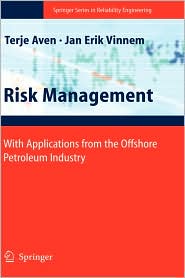 Book reviews
Book reviews-
Risk Management with Applications from the Off-shore Petroleum Industry
Detailed review of:
Risk Management with Applications from the Off-shore Petroleum Industry
Publishers
: Springer, London
Author
: Terje Aven and Vinnem Jan Erik
Title
: Risk Management with Applications from the Off-shore Petroleum Industry
Year of Publication
: 2007
Pages
: 200
ISBN
: 9781846286520
Reviewer
: Krishna B. Misra
Status
: Review published in IJPE, Vol. 4, No. 3, July 2008, p. 299.
The book consists of 8 chapters as follows:
Chapter 1:
Introduction
17 Pages
Chapter 2:
Risk Management Principles and Methods-Review and Discussion
57 Pages
Chapter 3:
A Risk Management Framework for Decision Support under Uncertainties
8 Pages
Chapter 4:
Applications – Concept Optimization
15 Pages
Chapter 5:
Applications – Operations Phase
11 Pages
Chapter 6:
Applications – Choice of Disposal Alternative
11 Pages
Chapter 7:
Applications- Risk Indicators, National Level
24 Pages
Chapter 8:
The Success Factors- Discussion
11 Pages
Appexdices
A: Foundational Issues of Risk and Risk Analysis
8 Pages
B: Example : ALARP Demonstration
9 Pages
References
8 Pages
Index
4 Pages
This book comes from authors who are professors at the University of Stavanger, Norway and have rich experience of researching and offering consultancy in the area of risk analysis and management, particularly with reference to off-shore oil and gas industry. The authors clarify in their preface that this book is about making decisions in the face of risks and uncertainties and they outline the challenges that go with this process of decision making. In the first chapter, the authors discuss in detail the fundamentals of risk management and nature and extent of problems associated with development of
off-shore oil and gas activity in the Norwegian continental shelf of North Sea. In the second chapter which is the lengthiest of all chapters, the principles of risk management are discussed starting with the definition of risk and various approaches for risk assessment. It also elaborates the use of expected values and portfolio theory for use in decision making after discussing cautionary and precautionary principles. This chapter also discusses the risk acceptance criteria and the process of making decision under uncertainties along with ethical aspect of risk acceptance criteria. The authors also provide a structure for risk analysis and decision making involving stakeholders without the use risk acceptance criteria. All these discussions centre around the application the concepts and methodologies to off-shore gas and oil industry, in fact more discretely in chapters 5-7. In the last chapter, the authors elaborate the success factors that help make a realistic application of concepts, analysis and management that have been discussed in earlier chapters of the book. Appendices provide the introductory material to what is presented in the book. Particularly, the Appendix B on ALARP is quite interesting and instructive.
In the opinion of the reviewer, this book has come around successfully in presenting its theme, theories and applications of risk management, more so to an off-shore gas and oil industry and would like to recommend to all risk analysts and managers. This book would also be found useful by the students and teachers at universities in pursuing or teaching a risk management course.
Krishna B. Misra
Review published in the International Journal of Performability Engineering, Vol. 4, No. 3, July 2008, p. 299.


